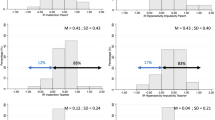Abstract
We evaluated plasma levels of DHEA-S and cortisol before and after treating ADHD patients with one of two medications: methylphenidate (n = 12) or bupropion (n = 10). Boys with ADHD (combined type) were evaluated with the Korean ADHD rating scale (K-ARS) and the computerized ADHD diagnostic system (ADS). All assessments were measured at baseline and repeated after 12 weeks. There were significant clinical improvements in both treatment groups as measured by K-ARS and ADS. DHEA-S levels increased from baseline to endpoint, but cortisol levels did not change significantly. This study suggests that both methylphenidate and bupropion increase plasma levels of DHEA-S in boys with ADHD.
Similar content being viewed by others
References
Elia J, Ambrosini PJ, Rapoport JL (1999) Treatment of attention-deficit-hyperactivity disorder. N Engl J␣Med 340(10):780–788
Arnsten AF (2006) Fundamentals of attention-deficit/hyperactivity disorder: circuits and pathways. J␣Clin Psychiatry 67(Suppl 8):7–12
Timimi S, Taylor E (2004) ADHD is best understood as a cultural construct. Br J Psychiatry 184:8–9
Dubrovsky BO (2005) Steroids, neuroactive steroids and neurosteroids in psychopathology. Prog Neuropsychopharmacol Biol Psychiatry 29(2):169–192
Strous RD, Spivak B, Yoran-Hegesh R, Maayan R, Averbuch E, Kotler M et al (2001) Analysis of neurosteroid levels in attention deficit hyperactivity disorder. Int J Neuropsychopharmacol 4(3):259–264
Maayan R, Yoran-Hegesh R, Strous R, Nechmad A, Averbuch E, Weizman A et al (2003) Three-month treatment course of methylphenidate increases plasma levels of dehydroepiandrosterone (DHEA) and dehydroepiandrosterone-sulfate (DHEA-S) in attention deficit hyperactivity disorder. Neuropsychobiology 48(3):111–115
Charalampopoulos I, Dermitzaki E, Vardouli L, Tsatsanis C, Stournaras C, Margioris AN et al (2005) Dehydroepiandrosterone sulfate and allopregnanolone directly stimulate catecholamine production via induction of tyrosine hydroxylase and secretion by affecting actin polymerization. Endocrinology 146(8):3309–3318
Volkow ND, Wang GJ, Fowler JS, Gatley SJ, Logan J, Ding YS et al (1998) Dopamine transporter occupancies in the human brain induced by therapeutic doses of oral methylphenidate. Am J Psychiatry 155(10):1325–1331
Gainetdinov RR, Wetsel WC, Jones SR, Levin ED, Jaber M, Caron MG (1999) Role of serotonin in the paradoxical calming effect of psychostimulants on hyperactivity. Science 283(5400):397–401
Ferris RM, Tang FL (1979) Comparison of the effects of the isomers of amphetamine, methylphenidate and deoxypipradrol on the uptake of l-[3H]norepinephrine and [3H]dopamine by synaptic vesicles from rat whole brain, striatum and hypothalamus. J Pharmacol Exp Ther 210(3):422–428
Challman TD, Lipsky JJ (2000) Methylphenidate: its pharmacology and uses. Mayo Clin Proc 75(7):711–721
Pliszka SR (2005) The neuropsychopharmacology of attention-deficit/hyperactivity disorder. Biol Psychiatry 57(11):1385–1390
Barrickman LL, Perry PJ, Allen AJ, Kuperman S, Arndt SV, Herrmann KJ et al (1995) Bupropion versus methylphenidate in the treatment of attention-deficit hyperactivity disorder. J Am Acad Child Adolesc Psychiatry 34(5):649–657
Conners CK, Casat CD, Gualtieri CT, Weller E, Reader M, Reiss A et al (1996) Bupropion hydrochloride in attention deficit disorder with hyperactivity. J Am Acad Child Adolesc Psychiatry 35(10):1314–1321
Rosenfeld RS, Hellman L, Gallagher TF (1972) Metabolism and interconversion of dehydroisoandrosterone and dehydroisoandrosterone sulfate. J Clin Endocrinol Metab 35(2):187–193
Longcope C (1996) Dehydroepiandrosterone metabolism. J Endocrinol 150(Suppl):S125–127
DuPaul GJ, Power TJ, Anastopoulos AD, Reid R (1998) The ADHD Rating Scale-IV: Checklists, norms, and clinical interpretation. Guilford Press, New York
So YK, Noh JS, Kim YS, Ko SG, Koh Y-J (2002) The reliability and validity of Korean parent and teacher ADHD rating scale. J Korean Neuropsychiatr Assoc 41(2):283–289
Shin MS, Cho S, Chun SY, Hong K-E (2000) A study of the development and standardization of ADHD diagnostic system. Korean J Child Adol Psychiatr 11(1):91–99
Salek FS, Bigos KL, Kroboth PD (2002) The influence of hormones and pharmaceutical agents on DHEA and DHEA-S concentrations: a review of clinical studies. J Clin Pharmacol 42(3):247–266
Strous RD, Maayan R, Lapidus R, Stryjer R, Lustig M, Kotler M et al (2003) Dehydroepiandrosterone augmentation in the management of negative, depressive, and anxiety symptoms in schizophrenia. Arch Gen Psychiatry 60(2):133–141
Demirgoren S, Majewska MD, Spivak CE, London ED (1991) Receptor binding and electrophysiological effects of dehydroepiandrosterone sulfate, an antagonist of the GABAA receptor. Neuroscience 45(1):127–135
Bergeron R, de Montigny C, Debonnel G (1996) Potentiation of neuronal NMDA response induced by dehydroepiandrosterone and its suppression by progesterone: effects mediated via sigma receptors. J␣Neurosci 16(3):1193–1202
Lehohla M, Kellaway L, Russell VA (2004) NMDA receptor function in the prefrontal cortex of a rat model for attention-deficit hyperactivity disorder. Metab Brain Dis 19(1–2):35–42
Guazzo EP, Kirkpatrick PJ, Goodyer IM, Shiers HM, Herbert J (1996) Cortisol, dehydroepiandrosterone (DHEA), and DHEA sulfate in the cerebrospinal fluid of man: relation to blood levels and the effects of age. J Clin Endocrinol Metab 81(11):3951–3960
Author information
Authors and Affiliations
Corresponding author
Rights and permissions
About this article
Cite this article
Lee, MS., Yang, JW., Ko, YH. et al. Effects of Methylphenidate and Bupropion on DHEA-S and Cortisol Plasma Levels in Attention-deficit Hyperactivity Disorder. Child Psychiatry Hum Dev 39, 201–209 (2008). https://doi.org/10.1007/s10578-007-0081-6
Received:
Accepted:
Published:
Issue Date:
DOI: https://doi.org/10.1007/s10578-007-0081-6




